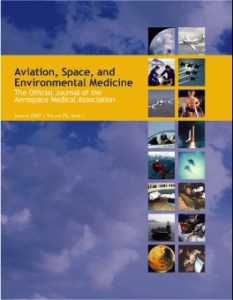Introduction: Visual performance impairment after hypoxia is well recognized in military and civilian aviation. The aims of this study were: 1) to assess oculometric features such as blink metrics, pupillary dynamics, fixations, and saccades as cognitive indicators of early signs of hypoxia; and 2) to analyze the impact of different hypoxic conditions [ “ hypoxic hypoxia” (HH) and “ isocapnic hypoxia” (IH)] on specified oculometrics during mental workloads.
Methods: Oculometric data were collected on 25 subjects under 3 conditions: normoxia, HH (8% O 2 + balance N 2 ), and IH (7% O 2 + 5% CO 2 + balance N 2 ). The mental workload task consisted of reading aloud linear arrays of numbers after exposure to gas mixtures.
Results: Blink rates were significantly increased under hypoxic conditions (by +100.7% in HH and by +92.8% in IH compared to normoxia). A faster recovery of blink rate was observed in transitioning from IH (23.6% vs. 76.3%) to normoxia. The percentage change in pupil size fluctuation was increased under HH more than under IH (29% vs. 4.4%). Under HH average fixation time and target area size were significantly higher than under IH. Total saccadic times under hypoxic conditions were significantly increased compared with normoxia.
Conclusions: These results suggest that oculometric changes are indicators of hypoxia, which can be monitored using compact, portable, noninvasive eye-tracking devices in a cockpit analogous environment to detect hypoxia-induced physiological changes in aircrew. Comparative results between HH and IH support the potential role of carbon dioxide in augmenting cerebral perfusion and hence improved tissue oxygen delivery.
Summary Points:
- Investigated oculometric tests as cognitive indicators of early signs of hypoxia.
- Blink rates increased, pupil size fluctuations increased, higher fixation time and target area size, and worse King-Devick Test scores were measured under hypoxic conditions (HH 8% O 2 + balance N 2) verses normoxia.
- The K-D Test measures saccadic function, which may be a reliable marker in neuro-physiological changes induced by hypoxia, and useful in assessing early signs of hypoxia prior to cognitive impairment.

